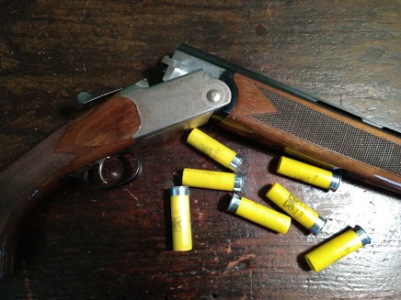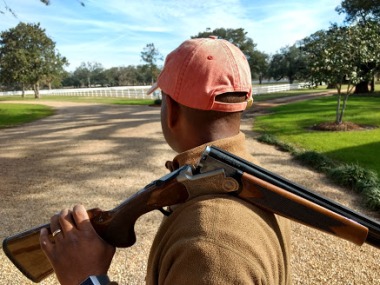 As the driver of a mule wagon at a quail hunting plantation, I have probably handed out more shotgun ammunition in the last few years than some gun store owners. I keep it in a compartment on the wagon at my feet—mostly 20 gauge and 28 gauge. Most people use 20 gauge shells since they carry a slightly larger load. Counter intuitively, the smaller the number, the larger the size of the shell.
As the driver of a mule wagon at a quail hunting plantation, I have probably handed out more shotgun ammunition in the last few years than some gun store owners. I keep it in a compartment on the wagon at my feet—mostly 20 gauge and 28 gauge. Most people use 20 gauge shells since they carry a slightly larger load. Counter intuitively, the smaller the number, the larger the size of the shell.
I keep a box of 12 gauge shells but have never had anyone ask for them. They are too large and powerful to use on the quail. I also keep a few boxes of slender 410 shells, which carry a much smaller load and seem to be for the serious, more skilled shooters.
Most people use a double-barreled, over and under shotgun that breaks down to load.  Their guns rest in a wagon box for the hunters who ride with me and in saddle scabbards for the horseback riders. I don’t handle the guns, so they are a bit of a mystery to me. But when you are around them as much as I am you can’t help but draw some conclusions.
Their guns rest in a wagon box for the hunters who ride with me and in saddle scabbards for the horseback riders. I don’t handle the guns, so they are a bit of a mystery to me. But when you are around them as much as I am you can’t help but draw some conclusions.
One observation is that shotguns aren’t really guns—not like we-need-to-get-guns-off-the-street guns. They are tools. They are works of art. They can be family heirlooms, passed down from generation to generation. To the serious hunter, a shotgun is more than just a gun.
If you search for shotguns at the big sporting goods retailers, they will range in price from a few hundred dollars up to $6,000. I overheard a conversation last week between two hunters in which they discussed a shotgun worth $30,000, so I went online to see what they might be talking about.
Perhaps they were discussing a shotgun produced by the English gun maker James Purdey & Sons, a company that has been supplying guns to royalty, aristocrats and the wealthy since 1814. The price for a Purdey, considered by many to be the ultimate in shotguns, is around $30,000 with a delivery time of over two years. They are, of course, lovingly built by hand. But if you’re going all-in on your shotgun, another British gun-maker offers the Holland & Holland “Royal” Deluxe shotgun, available for well in excess of $200,000.
In addition to the guns, I’ve also come to appreciate the art of shooting—especially with the break-down double-barreled gun. Two shots, that’s all you get. Shoot, break, eject, reload, and shoot. It’s like an exquisitely choreographed dance. I’ve seen it a thousand times, and it never gets old. I love the thrill of a double (when a person hits a bird with each of his two shots). Even more special is when someone hits two birds with one shot—probably just luck, but fun to watch, none-the-less. Once in a while we will host a guy who hunts with a 410 shotgun. Some of these guys knock down bird after bird. For them, shooting quail looks like instinct not aim.
The other extreme is the novice hunter who endures miss after miss. I never laugh at these guys since I couldn’t hit the side of a barn if I was standing inside it. I always feel for the novice. He’s nervous. The experienced hunter will grab his ammo before we leave the house in the morning. The novice hunter is often like the elderly lady in the checkout line at the grocery store who digs around in her purse looking for her checkbook after the cashier has rung up her groceries. This is the guy who waits until the dogs are on point and everyone has dismounted to hunt before he pats his vest pockets and realizes he needs something to put in his gun. This hunter also often fails to take enough shells and when the guide takes them off chasing birds that have set down after their first flight, I see him a hundred yards away patting his pockets before sending the scout scurrying back to the wagon for a box of shells. The inexperienced hunter may not hit a bird all day, but if he does, when he makes his first kill, everyone—even the wagon driver—cheers.
A final observation about the guns we use for quail hunting is how they sound. There is a  distinctive bang that all of us—horses, mules, dogs, and people—are used to. The hunters are often too far from the wagon for me to see what they are shooting at, but with two hunters and two shells in each gun, I can count the shots—one, two, three, four. Any fewer means someone failed to get off a shot. Perhaps he forgot to turn off the safety or waited until the birds were too far away.
distinctive bang that all of us—horses, mules, dogs, and people—are used to. The hunters are often too far from the wagon for me to see what they are shooting at, but with two hunters and two shells in each gun, I can count the shots—one, two, three, four. Any fewer means someone failed to get off a shot. Perhaps he forgot to turn off the safety or waited until the birds were too far away.
I have also learned that there is a different kind of bang, a much louder one. This is the sound of a hunter who has turned too far—the sound of a gun aimed in my direction. I can’t help but try to duck even though, from my perch on the wagon seat, I’m the highest target for miles around. Fortunately, nobody has ever come close to hitting me, but if they do some poor nurse is going to be digging a bucket-full of birdshot out of my backside.
Leave a comment